Do You Need To Add Water To Primer Miniatures
This article was originally posted past stgm on his blog weetoysoldiers.com .
.
September xix, 2005
I first came across gesso a few months ago on TheMiniaturesPage.com discussion forum. At once I was intrigued: Here was something that could be brushed on, was not-toxic, water-thinnable and water-washup, and works wonders as a primer? I must investigate!
- Intro
- Materials
- Mixing
- Examples
- Drying
- More Examples
- Decision
- Updates
- Glop information technology On
- Finished Models
Intro
I had primarily used spray-tin varieties of primers, anything from hobby-specific like the Tamiya Grey Surface Primer, to the hardware store-variety similar OSH or Krylon or Rustoleum Painter'south Touch. They all work well more or less, but, in my opinion, take a few major drawbacks. I, the weather and lighting condition has to be correct — besides much humidity or also windy or too belatedly at night, and you're out of luck. Second, and more than importantly, the solvent- and lacquer-based primers have nasty, often carcinogenic, toxic chemicals that I'd rather practise without. Third, unless you lot're really conscientious, it's easy to overapply the primer and finish upward with buried/obscured details.
Gesso is a thick-ish liquid surface preparatory compound used to prepare artist'southward canvass before painting. Information technology contains finely ground chalk with some sort of glue or binding agent. Different brands of gesso are fabricated differently — apparently some behave carcinogenic warnings, and some are certified non-toxic. I've also read that information technology's made of plaster of Paris with glue. Either mode, it provides an first-class agglutinative "molar" for pigment to take hold of onto. I've been priming miniatures with gesso for the by half-dozen months, and have been very pleased with results.
Now, the obvious downwardly side is that information technology is brush-applied, and thus, somewhat time-consuming. This may not thing if you are a sloooooow painter similar me, for whom the measure of progress and achievement is not the number of finished miniatures, simply rather a happily chaotic workdesk full of miniatures in progress. I've heard of people asking about airbrushing gesso, simply I honestly wouldn't recommend it — the mix is thick enough to guarantee blocking and messing up your airbrush. And if you thin it to the betoken of being able to somewhat successfully airbrush it with an external-mix airbrush, then I would venture to guess that it would lack the cohesion to human action properly equally a primer.
Materials
The local craft stores bear Liquitex brand (the just brand I've used) of acrylic gesso in white, black, and clear. Yous can tint the white and articulate gesso with inks or paints of your choice (well, you can lighten black gesso too, I suppose, just almost people volition discover it easier to go from white to darker than black to lighter). I started out with white gesso and tinted it with black craft acrylic pigment, to give a nice, neutral grey look. I thin information technology with Tamiya airbrush thinner, but you tin as well use distilled water. Liquitex website states that yous tin can use up to 1:4 ratio (20%) of water to gesso to thin, and to use water and the Liquitex Matte Medium in equal amounts if thinning more than 20%. I've thinned it style more twenty% using the Tamiya Airbrush Thinner, but I've found that thinner gesso tends to go scratched off easily in treatment.
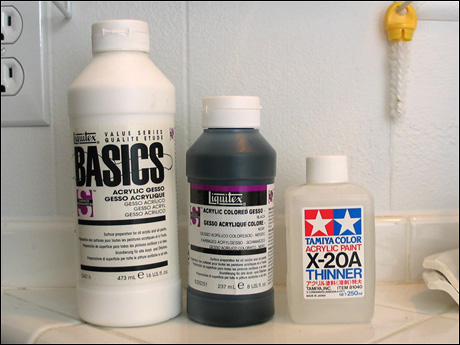
I eventually got a bottle of blackness gesso as well, as I found myself applying a coat of black ink wash to grey gesso-primed miniatures when I absolutely needed a blackness basecoat.
Here are my supplies for making primer mix — Gesso, Delta Ceramcoat arts and crafts acrylic black paint (99 cents at the local arts and crafts store), Tamiya airbrush thinner in a dispenser bottle, and of class, a mixing pot:
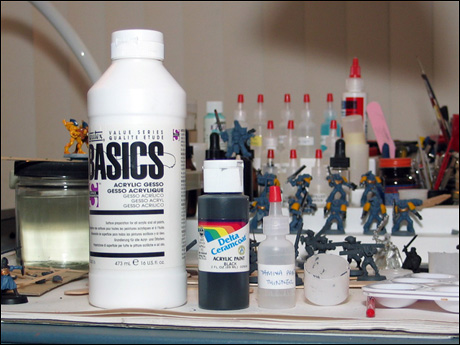
Mixing
The following paradigm shows the progression of mixing gesso: first you lot kickoff out with a dollop of gesso (the quantity obviously depending on how many miniatures you are going to prime!), then add black paint, then add thinner or water and mix thoroughly, and finally, you have a nice, shiny, polish solution of primer, gear up to use.
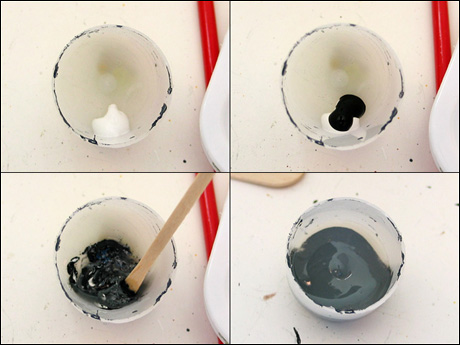
Examples
Here are two pictures of the Lord of the Rings plastic Warrior of Minas Tirith effigy, before and after priming with gesso:
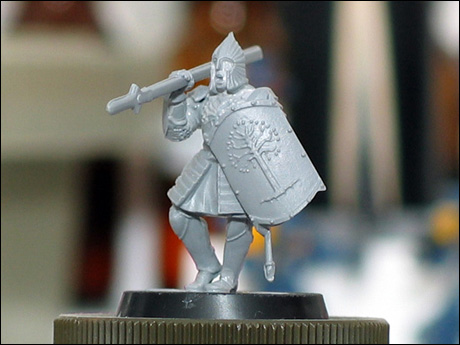
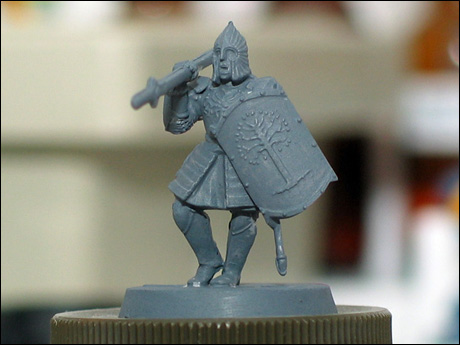
Drying
When applied, gesso goes on thick and obscures details, just as it dries, it shrinks down and goes on flat. In fact, it works so well that you can utilise information technology directly to prepainted figures with no loss of detail (this would obviously depend on how thickly the paint was used in painting the figure):
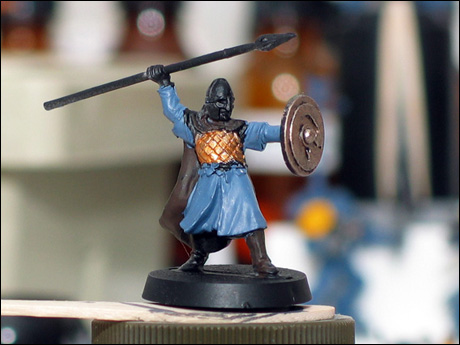
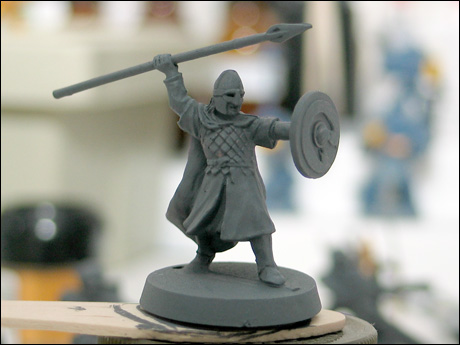
Another squeamish affair about working with gesso is that you lot accept absolute control over how it's applied. Put it on also thickly?
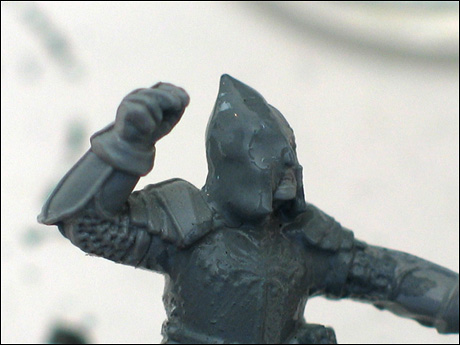
No problem! But use the brush to wipe away the excess. Much easier, cleaner, and safer than trying to damage-control over-applied spray can primers.
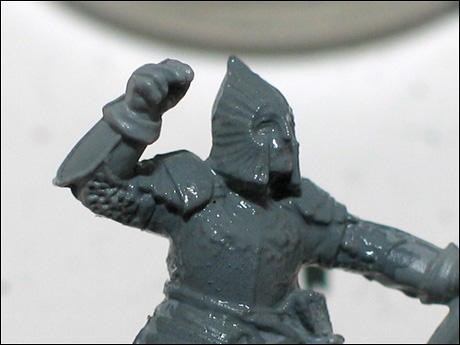
… find how gesso obscures details above when it'due south moisture. It dries downwards to reveal the details:
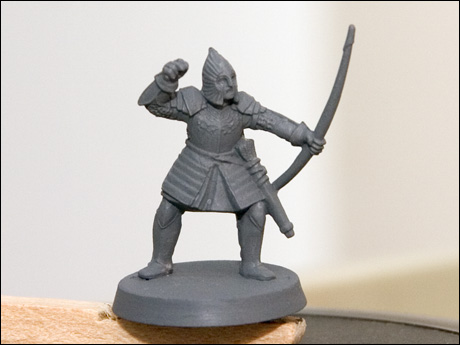
More Examples
Here is a comparison photo showing gesso-primed plastic gun (above), and before priming (beneath):
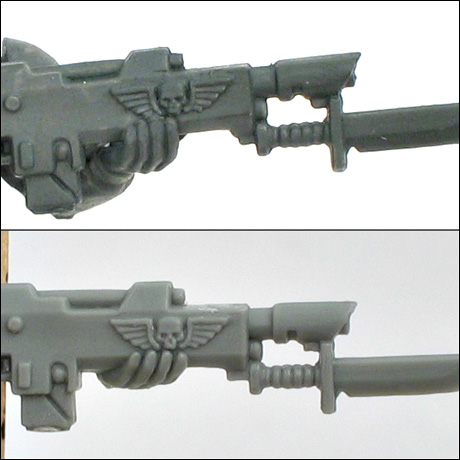
Here'due south a motion-picture show of a white-gesso-tinted-with-black primed metal miniature, from the Nighttime Age line of figures. The leftmost 1 is primed with gesso, then baremetal, then a figure primed with Tamiya spray can grey primer:
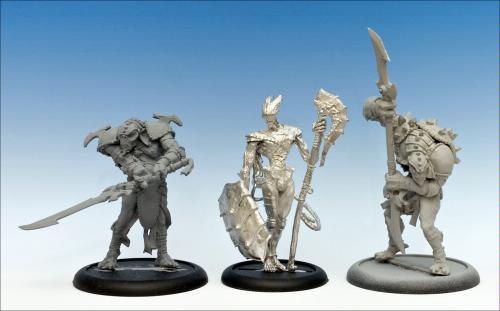
… and a closeup of the gesso-primed miniature:
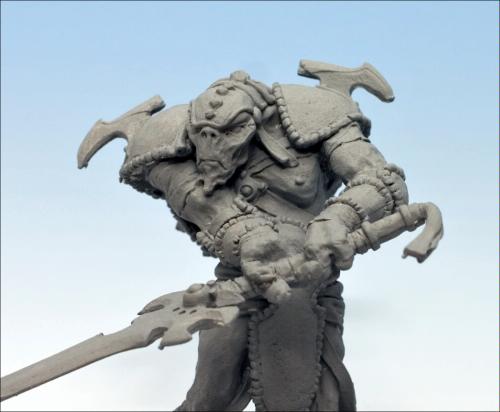
When the leftover gesso dries, it peels off in one rubbery piece:
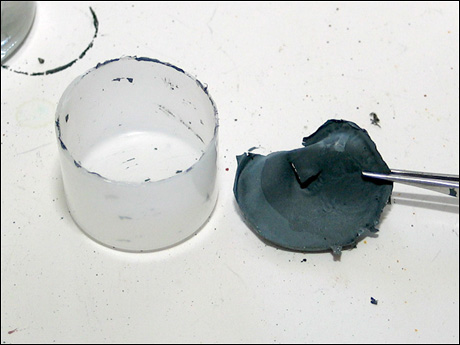
One note about gesso safety. Apparently, some brands of gesso come up with carcinogenic alert labels. The Liquitex make I apply is certified not-toxic, including coming together the California Proposition 65 requirements. Here's the blurb from the MSDS (Cloth Safety Datasheet) for their gesso:
"Product has been certified as non-toxic by The Art and Creative Materials Plant, Inc. and conforms to ASTM D-4236 Standard Practice for Labeling Art Materials for Astute and Chronic Agin Health Hazards."
Conclusion
There y'all take it. Obviously, if yous have hundreds of figures to prime at one time, or if y'all are working with smaller models (say 10mm and smaller) where any kind of primer might obscure details, it may not piece of work for you. Simply if you are looking for a safer, employ-at-any-time method of priming your miniatures, give gesso a shot!
Updates
Glop it On
Added: January 17, 2007
Over on TMP, there is a thread going on near using gesso as primer. Every bit regular visitors of WeeToySoldiers may know, I'm a large fan of using gesso for priming figures for many reasons, not the least of which is that I like to paint late at night, which effectively precludes using spray tin can primers.
One poster, a user of gesso, commented to the effect that y'all don't really need to add together water or otherwise thin gesso. His exact words were "jam the gesso into the crevices and glop information technology on. Dries perfectly sparse." This piqued my interest, also as (it must be admitted) a dose of skepticism. I've ever thinned my gesso, and have gotten skillful results with it. Oh certain, ordinarily y'all accept to go back and bear upon up where gesso shrank and created bare "pinhole" spots, just that's hands done (gesso shrinks as it dries, which makes information technology an platonic primer, as there is no or minimal loss of details). Thinned gesso besides seemed more decumbent to being scratched off or otherwise damanged in treatment, but I attributed that to just "gesso being gesso." To be sure, painted figures that were primed with gesso seem to wear handling merely fine.
And so, my curiosity being angry, I decided to experiment with not-thinned gesso, straight from the bottle, and furthermore, to "glop it on" and meet how it'd dry. For the experiment, a brave Urban Mammoth Junkers Convict Legionary "volunteered":
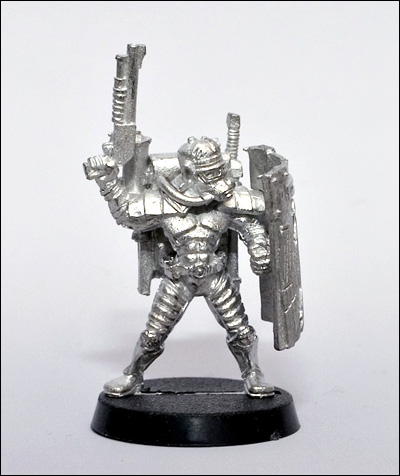
Here's my black gesso, a Liquitex make diverseness:
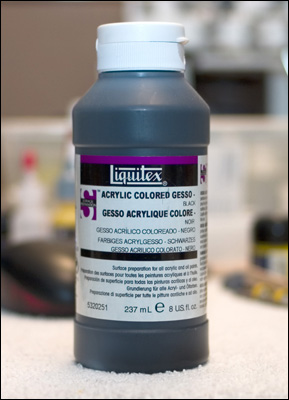
… and here's the gesso, direct from the canteen. I really ended upwardly using well-nigh 3x that amount, equally I applied information technology rather liberally!
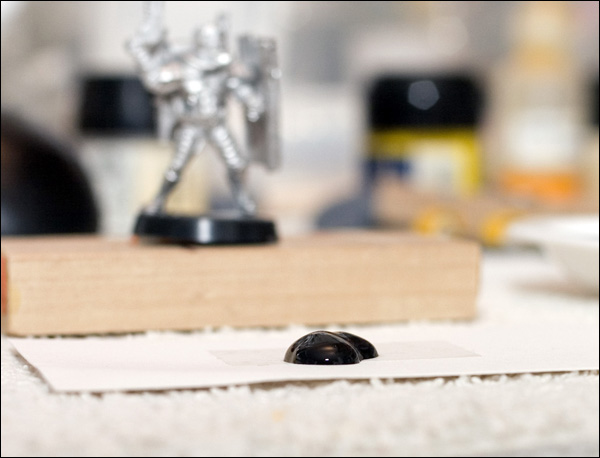
Now, here are the pictures of the experiment in progress. Commencement, we have the Legionary with its side and front profiles:
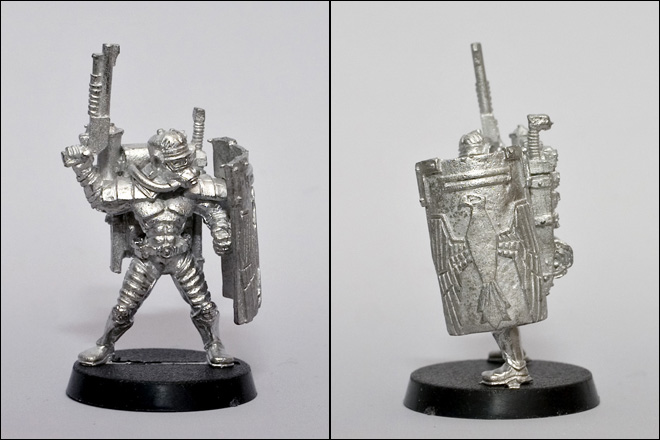
Here the gesso has been practical. Discover the complete loss of details! I had to edit the paradigm to overexpose the shots, to describe the details out.
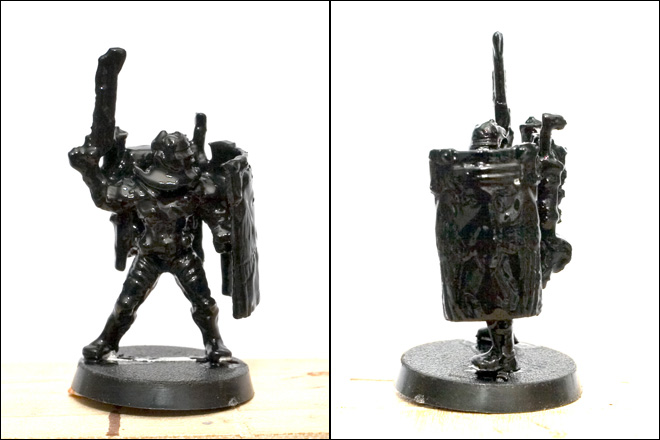
Some people say to allow gesso dry for 24 hours earlier painting over them. I don't know if that really makes that much difference. I've painted over gesso-primed figures subsequently equally little as a few hours, and have had no negative results, but I can't say conclusively that you have to or don't have to wait X number of hours.
Anyway, hither's the figure, two hours after the gesso was applied:
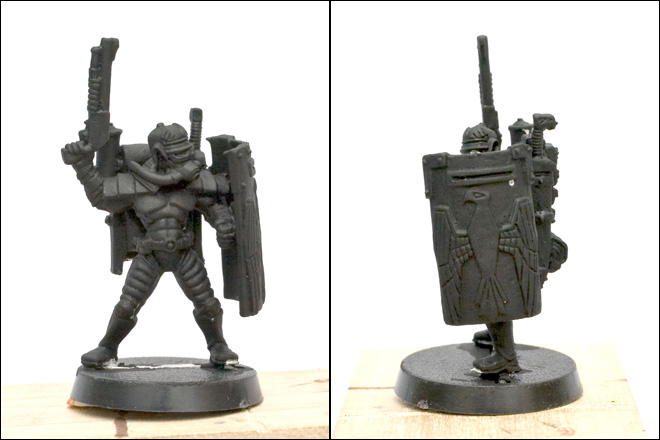
Well, I do stand up corrected! It seems pretty amazing that all that gesso stale upwards and shrank, merely it does seem to announced that that's the case, doesn't information technology? There's a pinhole blank spot on the shield that I'll need to touch upward, but the shrinkage-induced bare spots are far, far fewer and smaller than when I utilize thinned gesso. Well, how nigh that!
The next ii pictures testify comparison shots of the head surface area, and the shield details:
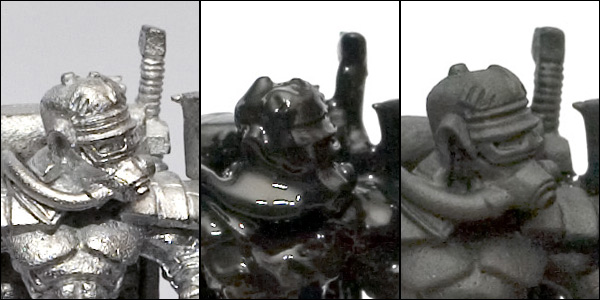
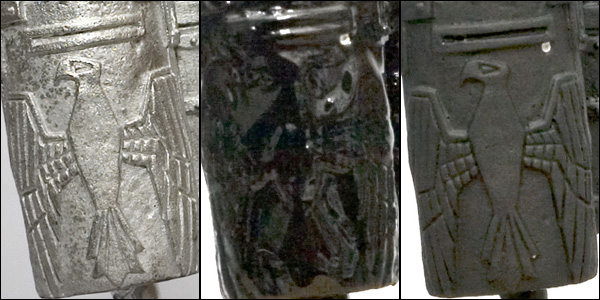
I'd be interested in hearing about your gesso techniques and habits!
Finished Models
Added: February 27, 2007
Hither are some finished miniatures that were primed with gesso.
The LotR Loftier Elf Warrior and the Ultramarine sergeant were primed with gesso; the Royal Fists marine in the middle was spray-can primed.
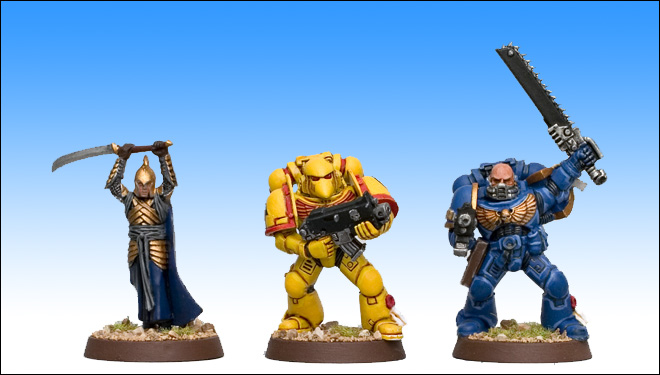
Dark Goblins from The Battle for Skull Pass gear up, primed with gesso:
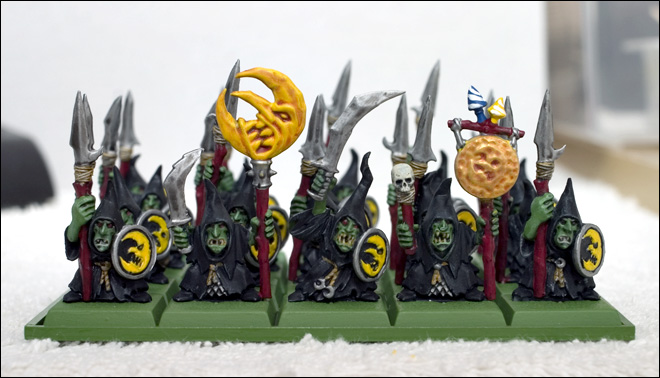
Dwarf Miners from the Skull Pass set, primed with gesso:
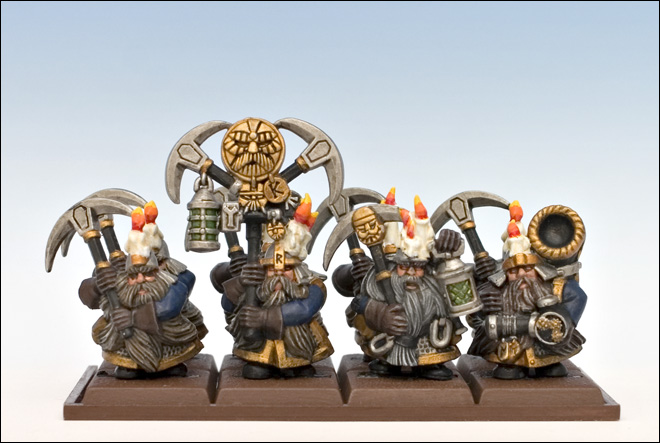
Skull Pass Dwarf Thane, again primed with gesso:
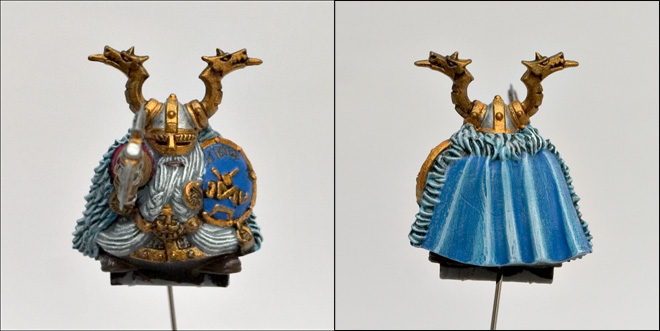
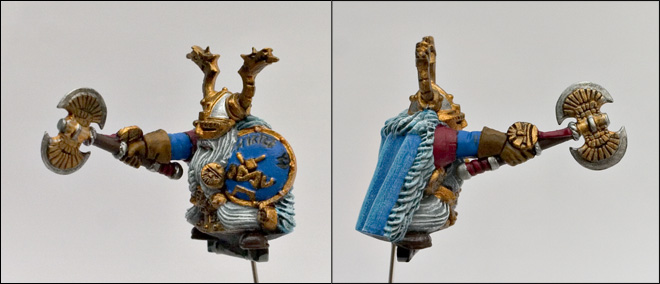
Skull Laissez passer Dwarf Warriors (tin can y'all tell what I've been working on lately…) :-D
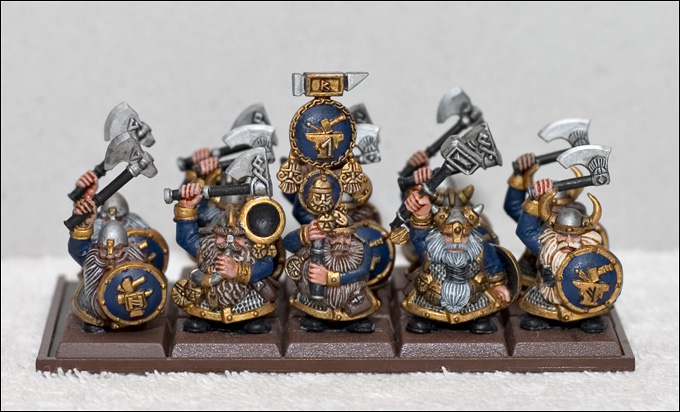
Do You Need To Add Water To Primer Miniatures,
Source: https://www.dakkadakka.com/wiki/en/Priming_With_Acrylic_Gesso
Posted by: sanderslawen1948.blogspot.com


0 Response to "Do You Need To Add Water To Primer Miniatures"
Post a Comment